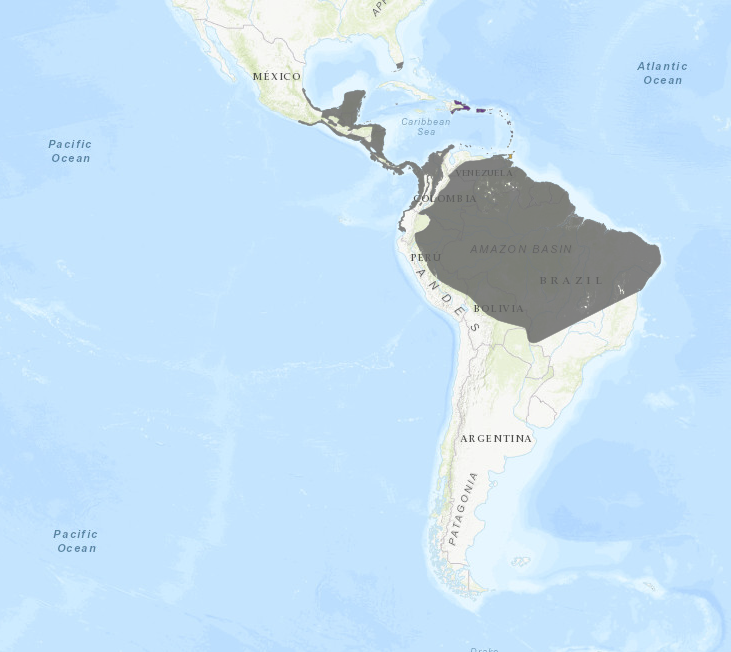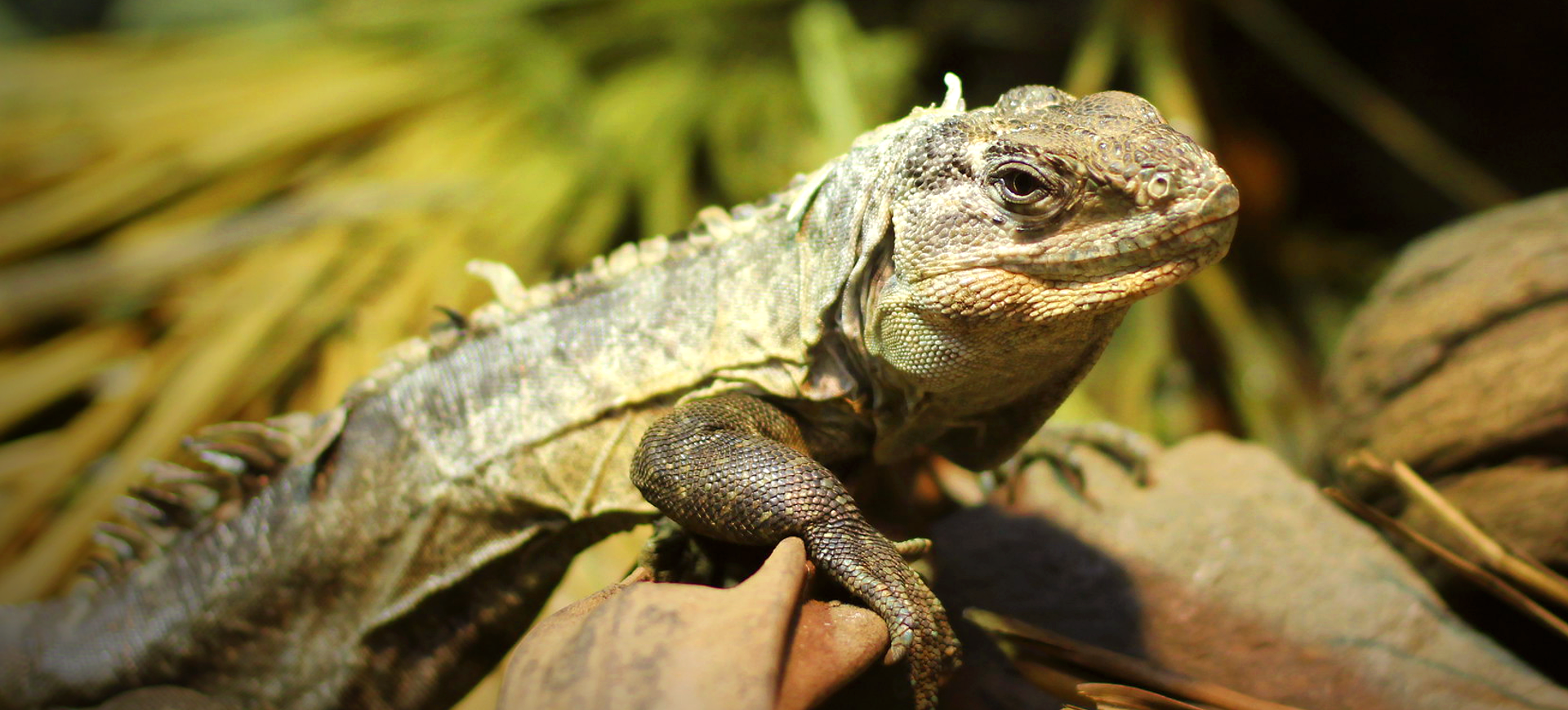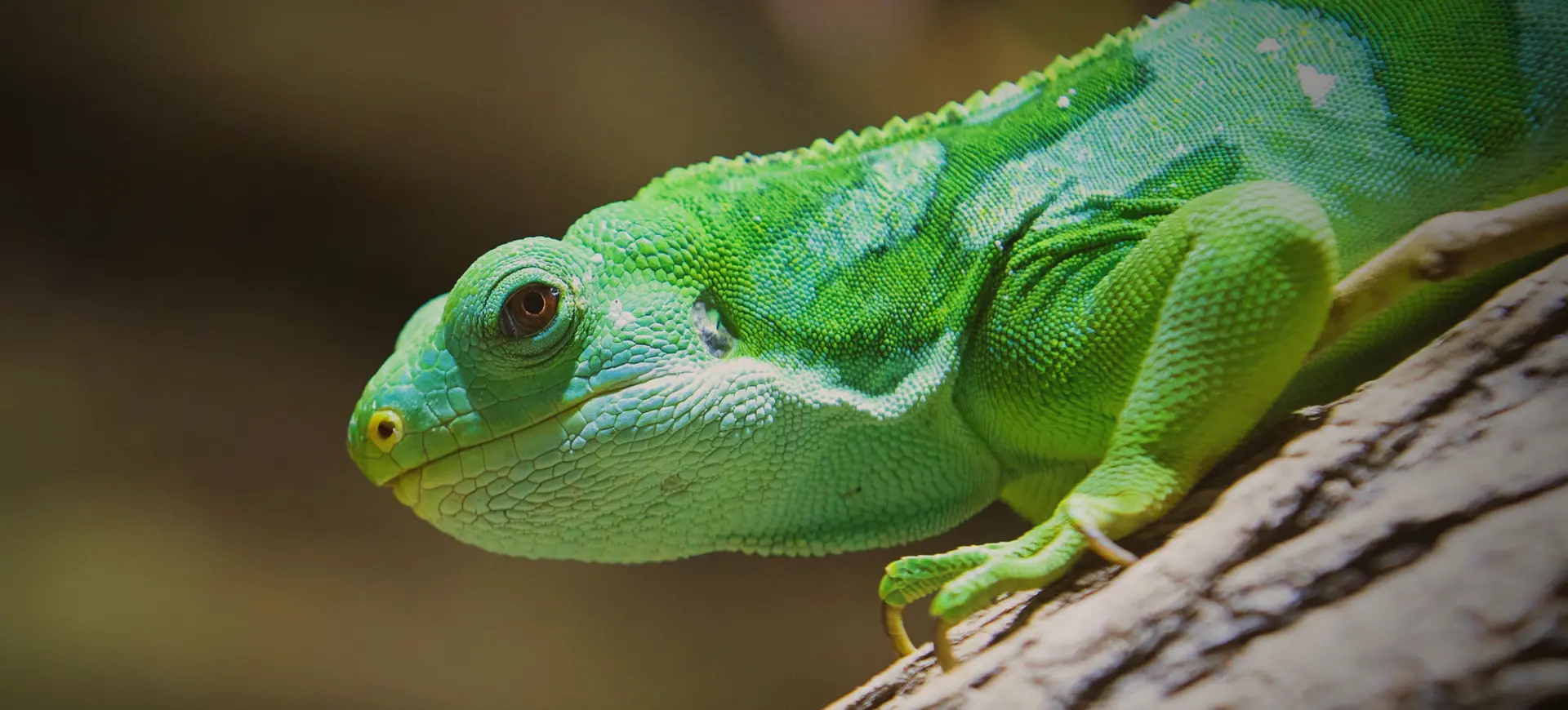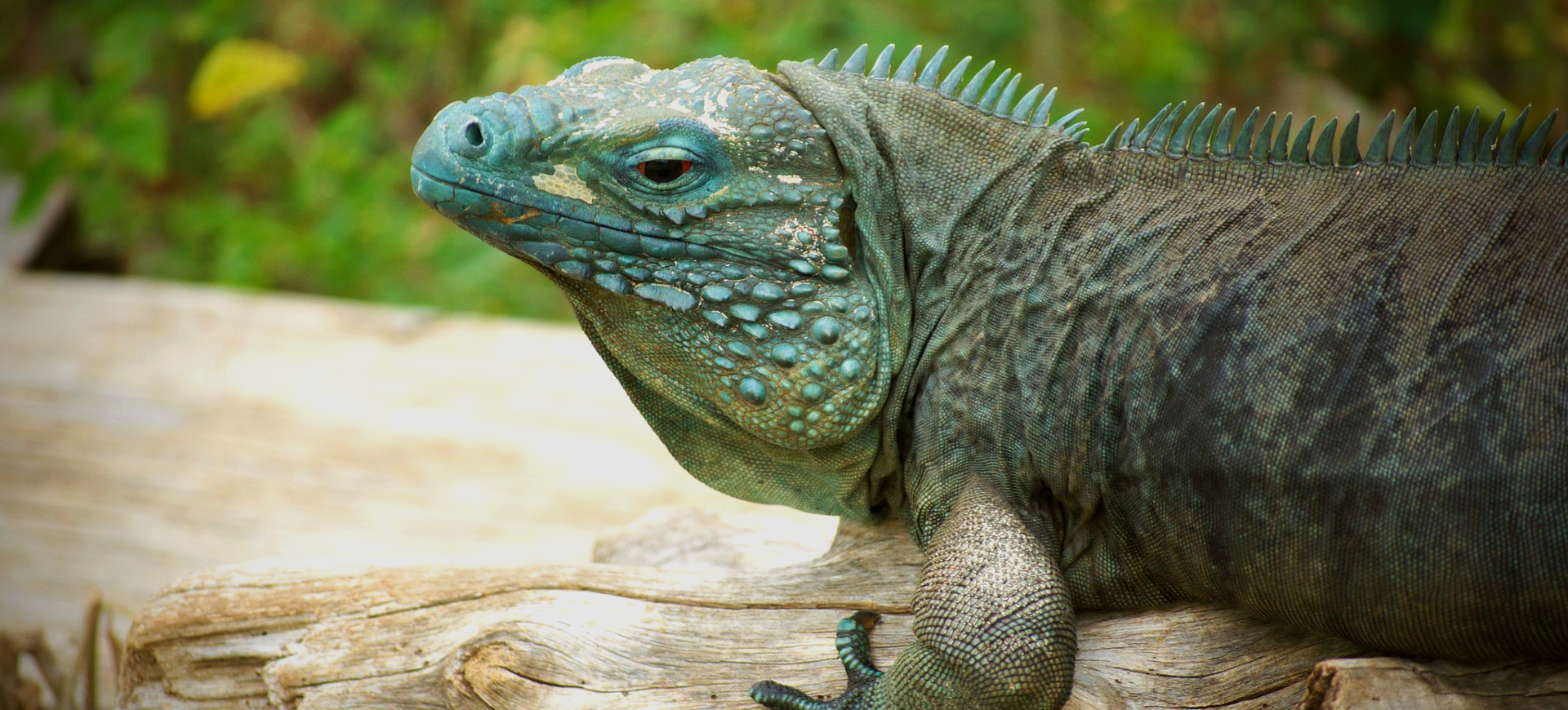Overview
The Green Iguana (Iguana iguana), a large, arboreal lizard native to Central and South America, is recognized for its vivid green coloration, serving as camouflage in its leafy habitats. This species has a row of spines running along its back to its tail, contributing to its dinosaur-like appearance, alongside a dewlap under its chin, used for thermoregulation and social signaling. Growing up to 6.6 feet in length, including their tail, Green Iguanas are among the largest lizards in the Americas. They are primarily herbivorous, feeding on leaves, flowers, and fruit, which marks a significant departure from the carnivorous diet typical of many other lizard species.
Green Iguanas are known for their excellent swimming abilities, often diving into water to escape predators. They have strong, powerful limbs equipped with sharp claws for climbing and holding onto branches in their arboreal lifestyle. In addition to their physical adaptability, Green Iguanas have a third “eye” on the top of their head, known as the parietal eye, which detects changes in light and dark, helping them to be aware of aerial predators. Despite their solitary nature, they come together during the breeding season, where males display aggressive behavior to assert dominance and attract females.
The habitat of the Green Iguana spans a wide range, including rainforests, swamps, and areas near rivers and streams, where they can bask in the sun and forage for food. Human activities have introduced Green Iguanas to areas outside their native range, where they have adapted and sometimes become invasive, impacting local ecosystems. Conservation efforts in their native habitats aim to address threats from habitat destruction, hunting, and the pet trade, which have led to declines in some populations. Despite these challenges, Green Iguanas remain a resilient and adaptable species, with a presence indicative of their ecosystems’ health and vibrancy.
Taxonomy
Kingdom
Phylum
Class
Order
Family
Genus
Species
Sub Species
Type
RANGE
Current distribution:
Originally native to Central and South America, Green Iguanas have been introduced to various regions outside their natural range, including Florida, Hawaii, and the Caribbean Islands. In these new environments, they have established populations and, in some cases, become invasive, posing challenges to local ecosystems. Despite the spread of Green Iguanas in non-native areas, their populations in native habitats face pressures from habitat loss, hunting, and the pet trade.
Efforts to monitor and manage the spread of Green Iguanas in non-native regions are ongoing, focusing on understanding their impact on local wildlife and vegetation. Conservation measures in their native range aim to protect habitat and reduce threats from human activities, ensuring the survival of Green Iguanas in the wild. The green iguana's resilience and adaptability have allowed it to thrive in a variety of conditions, but continued conservation efforts are needed to maintain balanced ecosystems and healthy populations.
Physical Description:
Green Iguanas exhibit a striking green coloration that ranges in shade from bright green to a more subdued olive, which helps them blend into their leafy surroundings. Their bodies are covered in soft, leathery scales, with a distinctive row of spines along their back that extends to the tail, offering protection from predators. The dewlap, a large flap of skin under the chin, serves multiple purposes, including communication, territorial displays, and thermoregulation. Adult iguanas also display a range of secondary colorations, such as blue, orange, and black, especially during the breeding season, which enhances their visual appeal.
Juvenile Green Iguanas are even brighter in color than adults, a feature that gradually changes as they mature. The long, powerful tail of the Green Iguana, which can constitute up to half of its total body length, is used as a defensive weapon, capable of delivering painful whips to deter predators. Their limbs are strong and muscular, equipped with sharp claws that aid in climbing and navigating their arboreal habitats. The overall physical design of the Green Iguana contributes to its striking appearance. It plays a critical role in survival, allowing it to escape predators, communicate with peers, and thrive in its natural environment.

Lifespan: Wild: ~10 Years || Captivity: ~20 Years

Weight: Male: 8.8-11 lbs (4-5 kg) || Female: 6.6-8.8 lbs (3-4 kg)

Length: Male: 60-72 in (152-183 cm) || Female: 54-66 in (137-167 cm)

Top Speed: 21 mph (34 km/h)
Characteristic:
Native Habitat:
Green Iguanas are native to a broad swath of Central and South America, thriving in various forested and wetland habitats. Their preference for areas with abundant foliage and access to water sources, such as rivers and streams, supports their arboreal lifestyle and dietary needs. Their adaptability to different environmental conditions has enabled them to inhabit a wide range of ecosystems, from dense rainforests to mangroves and even semi-urban areas where green spaces are available.
The critical importance of sunlight for thermoregulation and metabolic health dictates the habitat preferences of the Green Iguana, with individuals often found basking on tree branches or near water bodies. This need for sun exposure influences their daily activity patterns and spatial distribution within their habitat. Preserving their natural habitats is crucial for sustaining healthy populations, highlighting the impact of deforestation and habitat fragmentation on this species.
Biomes:
Biogeographical Realms:
Continents:
Countries:
Diet:
Diet & Feeding Habits:
The Green Iguana is primarily herbivorous, distinguishing it from many other large lizard species that exhibit carnivorous or omnivorous feeding habits. In the wild, its diet predominantly consists of leaves, flowers, and fruits, with a particular preference for foods that are high in calcium, which is crucial for its metabolic health. This dietary preference necessitates Green Iguanas foraging across various plants and trees to meet their nutritional needs.
In captivity, the dietary requirements of Green Iguanas are carefully managed to replicate their natural diet, emphasizing the importance of providing a varied and nutritionally balanced intake. Supplements are often provided to ensure adequate calcium and vitamin D3 levels, preventing metabolic bone disease, a common health issue in captive iguanas. Their herbivorous diet reflects the iguana’s role as a key consumer of plant materials, contributing to the ecological balance by dispersing seeds and maintaining vegetation growth.
Mating Behavior:
Mating Description:
The breeding season for Green Iguanas occurs once a year, with timing varying by geographic location but generally taking place during the dry season. Males display territorial behavior and engage in visual displays, such as head bobbing and dewlap extension, to attract females and assert dominance over rivals. These displays can escalate to physical confrontations if competing males invade each other’s territory.
Females lay clutches of 20 to 70 eggs in burrows or sandy areas, which they carefully excavate and then cover. The eggs are left to incubate with no further parental care, relying on the ambient temperature of their environment to determine the sex of the offspring, a phenomenon known as temperature-dependent sex determination. After a gestation period of approximately 90 days, the hatchlings emerge fully independent and capable of climbing and foraging for food.
Reproduction Season:
Birth Type:
Pregnancy Duration:
Female Name:
Male Name:
Baby Name:
Social Structure Description:
Green Iguanas are primarily solitary animals, with individuals establishing and defending territories, especially during the breeding season. These territories provide access to food, basking sites, and nesting areas, which are crucial for their survival and reproductive success. During the breeding season, male iguanas may display increased aggression towards other males, using visual and physical displays to assert dominance and attract females.
Social interactions among Green Iguanas are more common during breeding when individuals gather in areas suitable for mating and nesting. Outside this period, iguanas prefer to maintain a solitary existence, minimizing conflict and resource competition. Understanding the social structure of Green Iguanas is important for conservation efforts, particularly in managing populations in protected areas and captivity.
Groups:
Conservation Status:
Population Trend:
While the Green Iguana is currently listed as Least Concern by the IUCN, its population trend is decreasing in certain areas, primarily due to habitat loss, hunting for food and the pet trade, and the impacts of invasive species. In their native habitats, the conservation status of Green Iguanas varies regionally, reflecting the localized pressures that these animals face. Urbanization and agricultural development have led to significant habitat fragmentation, reducing the available space for these creatures to live and breed.
In regions where Green Iguanas have been introduced, they have shown remarkable adaptability, establishing robust populations that sometimes compete with native species for resources. Conservation efforts in native regions focus on habitat protection, sustainable management practices, and education to reduce illegal hunting and trade. The resilience of Green Iguanas, combined with targeted conservation initiatives, offers hope for their continued presence in their native and introduced ranges.
Population Threats:
Green Iguanas face several threats that impact their survival in the wild, including habitat destruction due to deforestation and urban expansion. The illegal pet trade also poses a significant risk, with many individuals captured for sale in domestic and international markets. Climate change and pollution also affect their habitats, altering the availability of food sources and suitable nesting sites.
Invasive species introduced to Green Iguana habitats compete for food and space, further stressing native populations. Diseases and parasites, exacerbated by habitat loss and climate change stress, can also impact iguana health and reproductive success. Addressing these threats requires comprehensive conservation strategies encompassing habitat protection, legal regulation of trade, and public education about the ecological value of Green Iguanas.
Conservation Efforts:
Conservation efforts for the Green Iguana include habitat preservation and restoration projects aimed at maintaining and increasing the availability of natural environments suitable for their survival. Legal protections have been established in some countries to regulate hunting and trade, reducing the impact of these activities on iguana populations. Environmental education programs are also crucial, raising awareness about the importance of Green Iguanas to their ecosystems and the threats they face.
Research and monitoring programs help better understand the needs of Green Iguanas and the challenges they encounter in native and introduced habitats. Rehabilitation and release programs for confiscated or injured iguanas contribute to population recovery efforts. International cooperation is essential for addressing the global trade in Green Iguanas, ensuring that conservation measures are effective across their range.
Additional Resources:
Fun Facts
- Green Iguanas can detach their tails if caught by a predator, a process known as autotomy. This allows them to escape and eventually regrow the lost portion.
- Despite being called “Green” Iguanas, individuals can exhibit a wide range of colors, including blue, orange, and even pink, depending on factors such as age, diet, and exposure to sunlight.
- Green Iguanas can survive falls from up to 40 feet high without injury, thanks to their sturdy skeletal structure and muscular build.
- The “third eye” on top of a Green Iguana’s head is not used for seeing images but can detect changes in light and shadow, helping to alert them to predators from above.
- Iguanas have a unique heart with three chambers, unlike the four found in mammals, which efficiently circulate blood throughout their body.
- The Green Iguana’s strong jaw and sharp teeth are designed for tearing vegetation, not chewing, so they swallow their food whole.
- Green Iguanas are considered a delicacy in some cultures and are farmed or hunted for food, known colloquially as “bamboo chicken.”
- Green Iguanas can hold their breath and remain submerged underwater for up to 30 minutes, aiding their escape from predators.
- The lifespan of a Green Iguana can more than double in captivity, with proper care and nutrition extending their lives significantly beyond their wild expectancy.
- Green Iguanas have been observed using visual signals, such as head bobbing and dewlap displays, to communicate with one another, especially during social interactions and territorial disputes.










